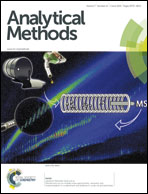Determination of methiocarb pesticide using differential pulse voltammetry with a boron-doped diamond electrode
Abstract
In this article, a simple and rapid method is described for voltammetric determination of methiocarb (MTC, a pesticide of the carbamate type). Direct oxidation of MTC at a highly positive potential of about +1.4 V vs. Ag/AgCl was found to be feasible, thanks to the excellent performance of the working boron-doped diamond electrode in combination with the differential pulse voltammetric ramp. After optimisation of important parameters, the signal of MTC could be calibrated in an interval of 1–55 μg mL−1 MTC, when offering a detection limit (3σ) of ca. 0.15 μg mL−1 MTC. The practical applicability of the method has been demonstrated on analyses of a commercial pesticide, either with respect to the total content of MTC or as its gradual and time-controlled dissolution in the model sample of the natural aquatic system.


 Please wait while we load your content...
Please wait while we load your content...